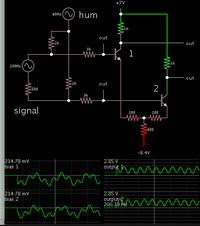benbiles
Member level 4

chnaged plan, went for PGA2500 digitally controlled preamps. 10db - 65db gain..
Hi Frank , thanks for your commentmakes total sence you don't want to have two faders per channel !! did'nt think of that one at all !!!
however, since i'm doing the fading digitaly in the dac I wont have that issue..
so, do I need to use 4 ic's (That 1280's) for the 8 channels to mix down to one single ended, then 8 resistor dividers + another OPAMP to recover level? or just the one IC with 16 devider resistors and a balanced output something like schematic i posted earlier?
I'm thinking, keep the signal balanced all the way through, becasue I can !! there will be a lot of other noisey stuff going on in the project so I'm hoping it might help with noise / interfearnce in the design to avoid single ended if I can..
I just ordered some OPA1632's for mic preamps for 8 channel differential ADC chip CS5368. the ADC needs 5Vpp input diferential, a bit less than the That 1510 / 1570 pre amps output. I guess I could have trimmed 1510 or 1570's back to 5Vpp but the OPA1632 just seamed to be made for the job.
well , i'll wire them up and hope i dont see a puff of smokeI'm hoping I can use my volt meter to see the Vpp outputs +/- peek with music or something to check before I blow anything up.. dont have either a sinal gen. or an oscillioscope
ok, i'm off to learn how to make 48v phantom power and preamp cuircit protection / rf choke on the inputs etc..ahhh!!! :bsdetector:


